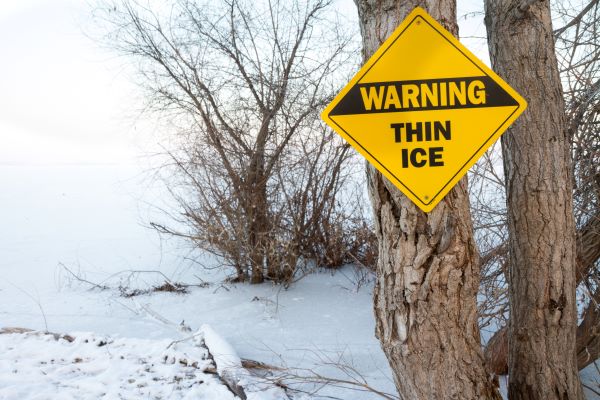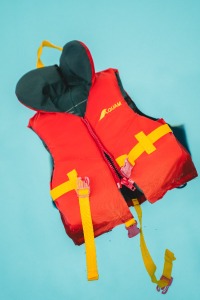Ice Safety
Many factors affect ice thickness including type of water, location, the time of year and other environmental factors such as: water depth, size of body of water, currents, tides and other moving water, chemicals including salt, fluctuations in water levels, logs, rocks and docks absorbing heat from the sun, and changing air temperature.
Ice colour is an important factor in ice safety awareness. You should know that:
- The colour of ice may be an indication of its strength.
- Clear blue ice is strongest.
- White, opaque or snow ice is half as strong as blue ice.
- Grey ice is unsafe. The greyness indicates the presence of water.

ALWAYS STAY OFF STORMWATER PONDS
Town of BWG by-laws prohibit skating and other recreation on stormwater management ponds as the ice thickness differs from one area to the next and there can be pockets of air and water in unexpected spots.| If you get into trouble on ice and you’re by yourself: |
| Shout for help. |
| Resist the urge to climb back out where you fell in. The ice is weak in this area. |
| Try to relax and catch your breath. Turn yourself toward shore so you are looking at where you entered onto the ice. The ice is more stable close to shore. |
| Reach forward onto the broken ice without pushing down. Kick your legs to try to get your body into a horizontal position. |
| Continue kicking your legs and crawl onto the ice. |
| When you are back on the ice, crawl on your stomach or roll away from the open area with your arms and legs spread out as far as possible to evenly distribute your body weight. |
| When You Are With Others on Ice |
| Rescuing another person from ice can be dangerous. The safest way to perform a rescue is from shore. |
| Shout for help. Consider whether you can quickly get help from trained professionals or bystanders. |
| Determine if you can reach them using a long pole or branch from shore – if so, lie down and extend the pole to the person. |
| If you go onto ice, wear a PFD and carry a long pole or branch to test the ice in front of you. Bring something to reach or throw to the person. |
| When near the break, lie down to distribute your weight and slowly crawl toward the hole. |
| Remaining low, extend or throw your emergency rescue device to the person. |
| Have the person kick while you pull. |
| Move the person to a safe position on shore. Signal for help. |
Lifejacket Lending Program
To ensure fairness and accessibility, the lifejacket lending program operates on a first-come, first-served basis. There is no need to make reservations; simply drop by the library and secure your lifejacket for a thrilling aquatic experience. The Library rental service allows for unlimited rentals, so you can embark on multiple aquatic escapades throughout the summer season.
Please note that an adult must check out the lifejackets and sign a waiver of responsibility. Both the Library and Leisure Center strive to provide a safe and enjoyable environment for all our patrons, and these measures help us achieve that goal.
The Lifejacket Lending Program runs from May 1-September 30.
Drowning Prevention Fundraising
Our goal for 2025 is to raise $2500.00.
You can donate online when you register for swimming lessons.



Backyard Pool Safety
The backyard pool provides the ultimate summer fun for kids, friends and family. But to keep it fun, it's important to know the risks so you can avoid danger - whether you own the pool, or you're just visiting. The single most important way to keep everyone safe is to ensure that young children are always supervised in and around the pool. If you know the risks, you can establish pool rules so everyone can stay safe and have fun.Backyard pool safety facts:
- Most common location for children under five drowning.
- Drowning is fast and silent - not like in the movies. There's no splashing and no screaming.
- Most backyard pools are too shallow for safe diving.
Backyard pool safety tips:
- Appoint an adult to actively supervise any children at the pool at all times.
- Keep children under five within arms' reach in and around the water.
- Control and restrict access to water - a latching gate and four-sided fencing can prevent accidents and unintended access to the water.
- Use the Society's Backyard Pool Safety Inspections Guidelines with the Backyard Pool Checklist.
- Empty/flip inflatable/kiddie pools when they're not in use.
Contact Us






